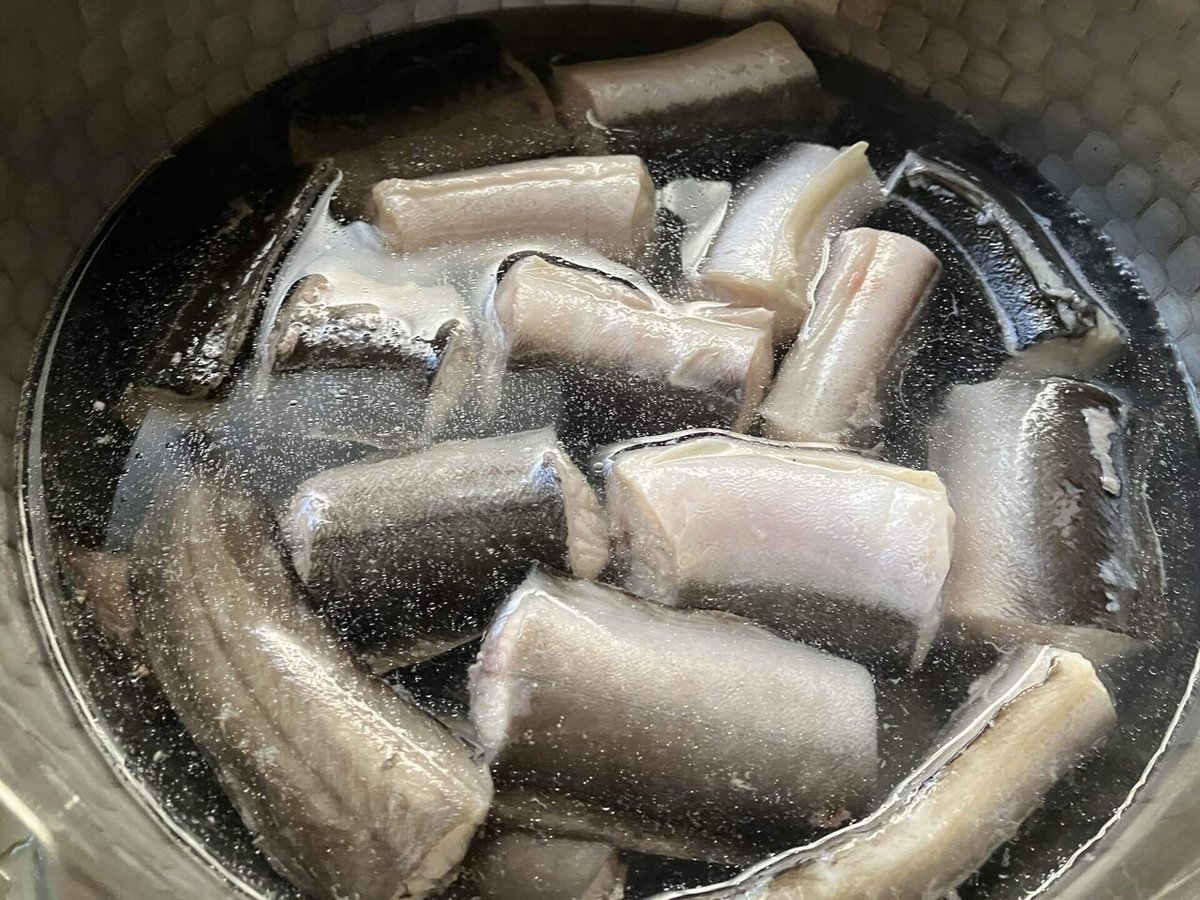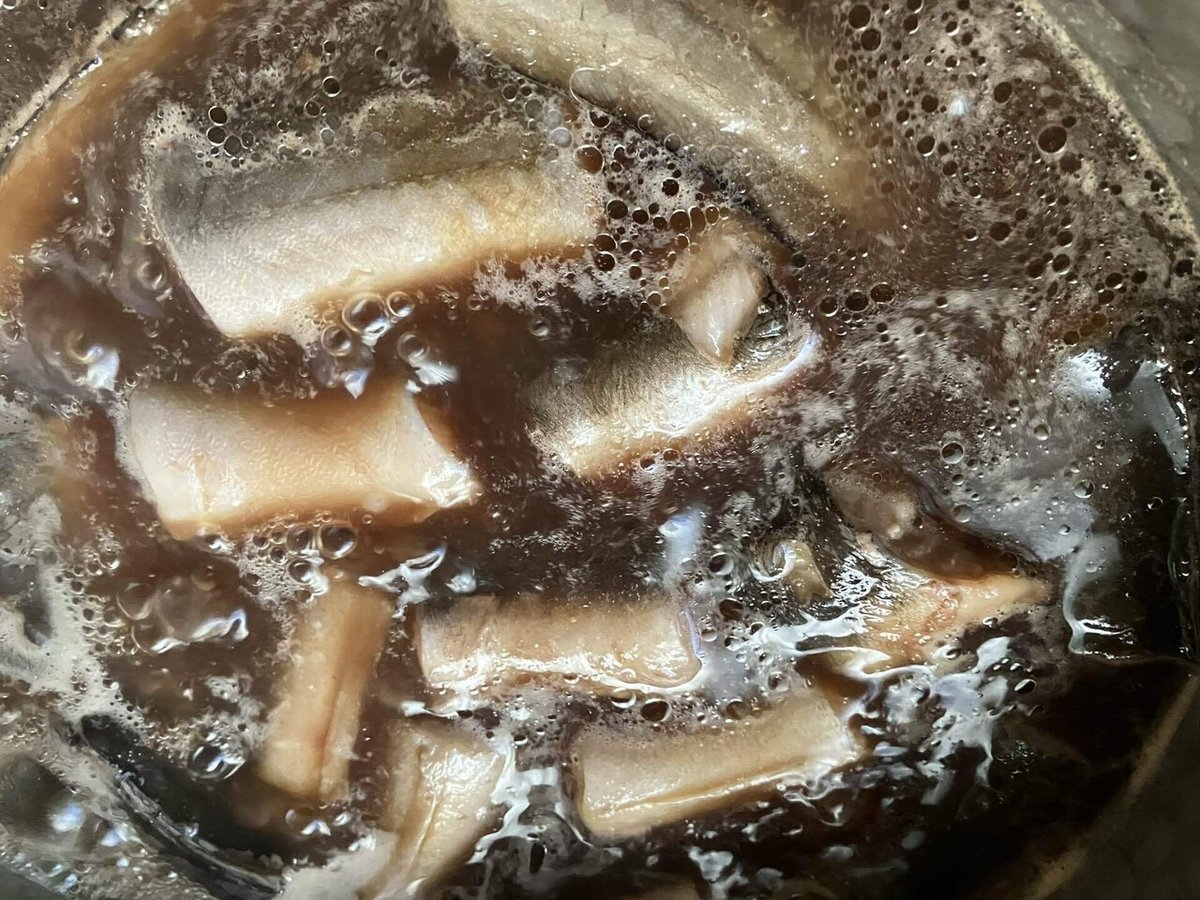
卸売市場で手に入れた活締め鰻のイタリア風前菜 Italian-style appetizer made with live eel purchased at a wholesale market :おまかせ小品集 Chef's choice dishes collection
深夜食堂(ドラマの深夜食堂よりずっと前のお話)」でお出しした料理の小品集。材料がある限り何でも出してました。ほとんど即興だったので何百種類も作りましたが、お客様のエピソードを思い出せるものを少しづつ再現します(差し支えある話は多少脚色しています)。
A collection of small dishes served on "Midnight Diner" (a story that took place long before the TV drama "Midnight Diner"). We served anything as long as we had the ingredients. Since it was mostly improvisation, we made hundreds of dishes, but we will recreate little by little the ones that remind us of our customers' episodes (we have dramatized some of the more inappropriate stories).
おまかせの時間
The inspiration for the recipe
高度成長の勢いがまだ残っていた頃、卸売り市場は盛況だった。築地はもちろんだが、僕の住んでいた神奈川にも幾つもの公設卸売市場があって、連日魚屋や料理人で賑わっていた。料亭、割烹や小料理屋、個人経営の居酒屋が全盛で、通販や産直が一般的ではない時代だったので、鮮度の高い水産物が欲しければ、卸売市場に出向くしかなかったからだ。馴染みの客と深夜まで酒を酌み交わして、1時間だけ仮眠し、五時には市場に車で買い出しに行く様なタフな料理人も結構いた。その後は、高度成長の名残が消え、大手スーパーが産直で水産品の流通を押える様になり、チェーンの居酒屋が増えてきて、市場には人影がまばらになり、多くの公設市場は閉鎖されてしまった。
僕は、価格破壊の個人経営の安酒場の立ち上げやコンサルをよく引き受けていたので、規模を縮小しながらも存続している市場との取引は続けていた。頻繁に足を運べば、流通の仕組みや相場感がよく分かるからだ。サプライズ演出のため、そこいらの魚屋や流通業者が目をつけていない種類の魚介類を手に入れることも必要だった。
僕がカウンターに立つと、料理ショーばりに手順を見せながら調理するので(僕は技巧派の料理職人ではないので、僕の拙い手捌きくらいなら、自分の方が上手にやれる、と思われていたふしがある)、料理好きの趣味人や自分の店を持ちたい料理自慢の連中が集まってくる。そういえば、料理研究家が急に増えたのもこの頃だった。終身雇用制の限界が見え、大きくなくても良いから自分で個性的な店をやってみようという、時代の流れの始まりだ。そんな経緯もあり、彼らを集めて、何度も卸売市場ツアーをやった。水産卸売市場は、ルールさえ知っていれば、誰でも現金取引できるのだが、初めて足を踏み入れるには勇気が要った。そのガイド役を僕が引き受けたのだった。
今では「八面六臂」とか「魚ポチ」とか、特殊な魚種を扱う流通業者もあるが、僕がツアーをやっていた20年前は、まだまだ卸売市場の価値は大きかった。今でも市場に行かないと手に入らない食材の代表に「鰻」がある。捌くテクニックが必要と思うかもしれないが、実は、市場ではわずかな手数料で、捌いたり串に刺してくれる。頭や骨、肝などのアラが手に入るのも利点だ。流石に半生の修行が必要な鰻職人は別格だけど、安い鰻串を出す立飲み屋なら、素人が開業するのも夢ではない。そんなツアー仲間達と試作した料理を再現した。鰻を喰うのは日本人だけではない。この魚は鱧と同様、生命力が強いので、冷蔵庫のない時代には、産地では重宝なタンパク源だったのだ。色んな応用ができるが、今回作ったのは昔イタリアで食べた、日本では珍しい「鰻のワイン煮」。
When the momentum of the high economic growth was still lingering, wholesale markets were thriving. Not only Tsukiji, but also Kanagawa, where I lived, had several public wholesale markets, which were bustling with fishmongers and chefs every day. It was a time when restaurants, traditional Japanese restaurants, small restaurants, and privately owned izakayas were in their heyday, and mail order and direct from the producer were not common, so if you wanted fresh seafood, you had no choice but to go to the wholesale market. There were quite a few tough chefs who would drink with regular customers until late at night, take a nap for just an hour, and then drive to the market at 5 to buy things. After that, the vestiges of high economic growth disappeared, major supermarkets began to control the distribution of seafood products by direct from the producer, chain izakayas began to increase, markets became sparsely populated, and many public markets were closed.
I often took on the task of starting up and consulting for privately run cheap bars that would smash prices, so I continued to do business with the markets that were still in existence, even though they had downsized. By visiting frequently, I could get a good understanding of the distribution system and market conditions. In order to create a surprise, it was also necessary to get hold of types of seafood that local fishmongers and distributors had not noticed.
When I stood at the counter, I would cook while showing the steps like in a cooking show (I am not a skilled chef, so people probably thought that they could do my clumsy handling better than me), so people who love cooking and are proud of their cooking skills and want to have their own restaurant gathered there. Come to think of it, it was around this time that the number of cooking researchers suddenly increased. The limits of the lifetime employment system were becoming apparent, and this was the beginning of a trend in which people wanted to try opening their own unique restaurant, even if it was not big. With this background, I gathered them together and took them on many wholesale market tours. Anyone can trade in cash at the seafood wholesale market as long as they know the rules, but it took courage to step inside for the first time. I accepted the role of guide.
Nowadays, there are distributors such as "Hachimenrokubi" and "Uopochi" that handle special fish species, but 20 years ago when I was doing tours, the value of wholesale markets was still great. Even now, eel is one of the representative ingredients that can only be obtained by going to the market. You might think that you need the skill to prepare it, but in fact, the market will prepare it and skewer it for you for a small fee. Another advantage is that you can get the head, bones, liver, and other parts of the fish. Of course, becoming an eel chef is a different matter, as it requires half a lifetime of training, but it's not a dream for an amateur to open a standing bar that serves cheap eel skewers. I recreated a dish that I tried out with my tour companions. Japanese people are not the only ones who eat eel. This fish, like conger eel, has a strong vitality, so in the days before refrigerators, it was a valuable source of protein in the areas where it is produced. There are many applications for eel, but this time I made "eel stewed in wine" that I ate in Italy a long time ago, which is rare in Japan.
Today's Ingredients:
今日の素材:
市場で仕入れた活け締め鰻(丸のままと開き)
鰻の骨とアラ(タダでもらえる)
赤ワイン(軽いもの。あるいは白ワインでも良い)
バルサミコ酢
りんご酢
ディル
胡椒
濃口醤油(あるいは九州醤油)
黒糖
自然塩
Freshly caught eel (whole and filleted) purchased from the market
Eel bones and bones (given for free)
Red wine (light, or white wine is fine)
Balsamic vinegar
Apple cider vinegar
Dill
Pepper
Dark type soy sauce (or Kyushu soy sauce)
Brown sugar
Natural salt
procedure:
つくり方:
(鰻のワイン煮の作り方)
鰻は、頭を切り落として、塩などでよく滑りを取り、骨ごとぶつ切りにする。頭と肝は取っておく。
取っておいた頭と貰ってきた頭と骨をグリルで焼く。
焼いた骨と頭に水と赤ワイン、バルサミコ酢を入れて、十五分ほど煮て、タレを作る。
ぶつ切りにした鰻を別の鍋に入れ、水を注ぎ、沸騰したら、茹で汁を捨てる。
そこに、作っておいたタレとりんご酢をひたひたになるくらい入れ、ディルと塩も入れる。タレは余らせておく。
落とし蓋をして、煮汁がほぼ無くなるまで煮込む。
5日程度の保存が可能。冷いままでも、温めて提供しても良い。
(How to make eel braised in wine)
Cut off the head of the eel, remove any slipperiness with salt, and chop it into chunks with the bones. Set aside the head and liver.
Grill the set aside head and the head and bones you received.
Add water, red wine, and balsamic vinegar to the grilled bones and head, and simmer for about 15 minutes to make the sauce.
Put the chopped eel in another pot, pour in water, and bring to a boil, then discard the cooking water.
Add the prepared sauce and apple cider vinegar until it is completely covered, and add the dill and salt. Reserve some of the sauce.
Cover with a drop lid and simmer until the cooking liquid is almost gone.
It can be stored for about 5 days. It can be served cold, or heated.



(おまけの鰻丼の作り方)
普通に米を炊いておく。
前の工程で作ったタレに、醤油と黒糖を入れて煮詰める。
開いてもらった鰻を、よく洗って、滑りも取る。
魚グリルなどで、鰻を裏面から、こんがりと焼く。裏返して皮方もこんがりと焼く。
焼いた鰻を、崩さない様に注意しながらタレにからめ、ご飯の炊き上がりに合わせて、もう一度、香ばしくグリルで炙る。
煮詰めたタレの半量をご飯に回しかけ、鰻を乗せて、残ったタレを上からかける。
(How to make the bonus eel bowl)
Cook rice as usual.
Add soy sauce and brown sugar to the sauce made in the previous step and simmer.
Wash the eel thoroughly after it has been opened and remove any slippery parts.
Grill the eel on a fish grill or similar until it is golden brown from the underside. Turn it over and grill the skin until it is golden brown as well.
Coat the grilled eel in the sauce, being careful not to break it apart, and once the rice is done, grill it again until it is fragrant.
Pour half of the reduced sauce over the rice, place the eel on top, and pour the remaining sauce on top.




ヒントとバリエーション
Recipe tips and variation
卸売市場の大きなところには、鰻問屋があって、活け以外に、その場で活け締めして、開いたり、いくらかの手数料で、串に刺したりのサービスもしてくれる。通常は、その際、骨や頭は捨ててしまうので、もらってくれば、鰻串の安い商売もできる。鰻本体が高くても、骨せんべいや肝串、頭焼きなどで、利益が取れるからだ。
商売が目的ではなくとも、家庭パーティーのための趣味の買い付けにも、鰻料理をかなり安く振る舞うことができる。何よりも、あの価格を維持している良心的なプロの鰻屋さんの努力や誠実さも、理解できるので、一度仕入れを経験しておくのも、グルメな体験を深めるために役に立つのではないかと思う。
鰻の味付けには、ヨーロッパではよく酢やトマトなどの酸味が使われている。甘辛にすっかり慣れてしまった日本人には馴染めないかもしれないが、僕は結構好きなので、あえて、日本人の好みを外し、酸味を効かせた砂糖は使わないレシピにしてある。酸味を減らして、ディルの代わりにシナモンを入れて、黒糖や味醂、蜂蜜などを足せば、日本人好みの味に近づけることもできるので、そこはお好みで。もっとワイルドな食べ方では、イタリアの屋台の様に、開いた鰻を塩焼きして、レモンだけを絞って食べるのもアリだ。上品な日本式白焼も良いものだが、ぼくには、野趣味があって大好きな食べ方。
グリルする場合は、炭火を起こせるなら、そのほうがずっと美味しいので、バーベキューのメインの一つに持ってくるのも良いだろう。
In the large wholesale markets, there are eel wholesalers who, in addition to selling live eels, will also kill them on the spot, open them up, and skewer them for a small fee. Usually, the bones and heads are thrown away, so if you take them, you can sell eel skewers at a low price. Even if the eel itself is expensive, you can make a profit by selling bone crackers, liver skewers, and grilled heads.
Even if you are not aiming for business, you can serve eel dishes at a very low price as a hobby purchase for a family party. Above all, you can appreciate the efforts and sincerity of the conscientious professional eel shop that maintains those prices, so I think it would be useful to experience purchasing eels once to deepen your gourmet experience.
In Europe, eel is often seasoned with sour ingredients such as vinegar and tomatoes. Japanese people, who are used to sweet and spicy dishes, may not be used to this, but I quite like it, so I have made a recipe that goes against Japanese tastes and does not use sugar to add sourness. If you reduce the sourness, use cinnamon instead of dill, and add brown sugar, mirin, honey, etc., you can make it closer to Japanese tastes, so it's up to your preference. A more wild way to eat it is to grill the opened eel with salt and eat it with just a squeeze of lemon, like in the Italian food stalls. The elegant Japanese-style shirayaki is also good, but for me, it's my favorite way to eat it because it gives off a rustic vibe.
If you are grilling, if you can make a charcoal fire, it is much more delicious, so it would also be a good idea to have it as one of the main dishes at a barbecue.
Guide to where to get ingredients and equipment 材料と機材の入手先ガイド
※Amazonのアフェリエイトに参加しています。もしご購入の際はここからクリックしてご購入いただけると、コーヒー代の足しになるので、嬉しいです。ちなみに僕はコーヒー依存症です。
*I participate in Amazon affiliate programs. If you purchase this product by clicking here, it will help pay for my coffee, so I would be very happy. By the way, I am addicted to coffee.
この記事が気に入ったらサポートをしてみませんか?
